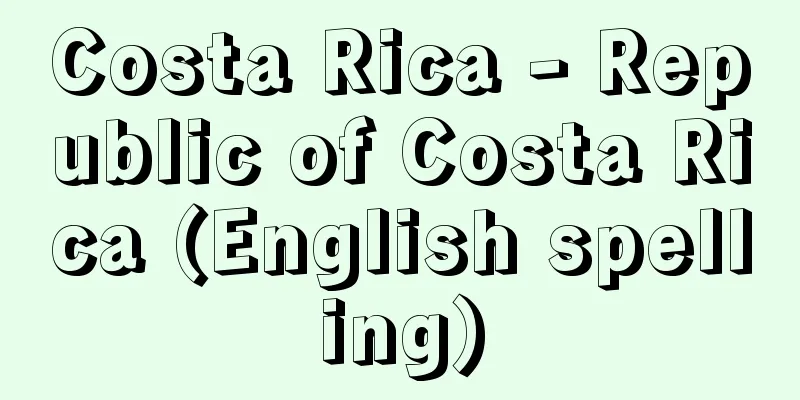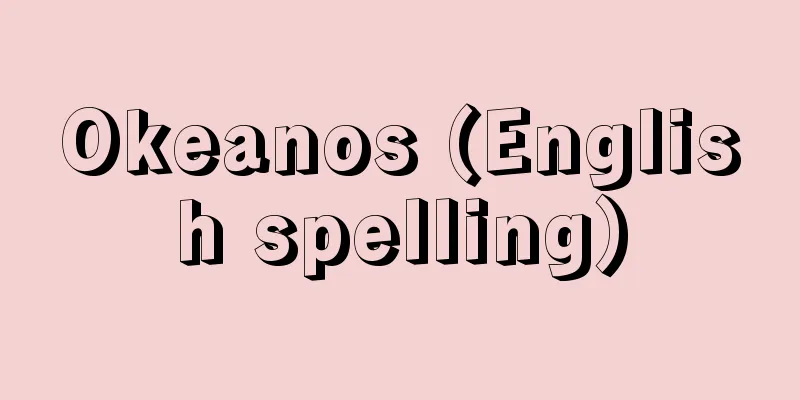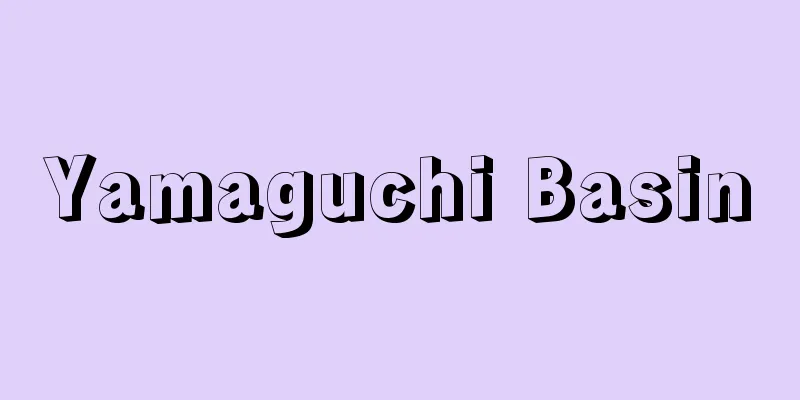Costa Rica - Republic of Costa Rica (English spelling)

|
A country in southern Central America. Its official name is the Republic of Costa Rica (República de Costa Rica). It borders Nicaragua to the north and Panama to the south, the Caribbean Sea to the east, and the Pacific Ocean to the west. Costa Rica means "rich coast" in Spanish, and it is said that the name of the country comes from the words shouted by Columbus when he reached the current port of Limon in the Caribbean in 1502. Its area is 51,100 square kilometers, and its population is 4,354,000 (2006 estimate), 4,579,000 (2009 estimate). Its capital is San Jose. [Konno Shuhei] NatureOf the total area, approximately 38% is forest, 46% is grassland, and 10% is cultivated land and orchards. The coastline on the Caribbean side is monotonous and approximately 250 km long, while on the Pacific side it is complex, stretching to 1,100 km, including the Nicoya Peninsula and the Osa Peninsula. From the northwest to the southeast of the country run mountain ranges such as the Guanacaste Mountains, the Central Mountains, and the Talamanca Mountains. The elevation increases toward the southeast, and the country's highest peak, Mount Chirripo (3,820 meters), is located in the southern Talamanca Mountains. There are also many active volcanoes, including Irazu, Barba, Turrialba, and Poas. The eastern lowlands extend toward the Caribbean coast. In the area surrounded by the Central Mountains and the Talamanca Mountains, there is a gently sloping central highland called the Meseta Central, which is 900 to 1,200 meters above sea level. The Pacific coast is dominated by rugged hills, with the central lowlands of the Central Rift Valley, which is connected to the Meseta Central. The Gulf of Nicoya is also surrounded by the Nicoya Peninsula. The southern Pacific coast has little flat land, with the Gulf of Dulce surrounded by the Osa Peninsula and Cabo Bricà, which borders Panama. The climate is dominated by northeast trade winds, and the lowlands east of the Central Mountain Range are tropical rainforests with some areas receiving more than 5,000 mm of rainfall per year. In contrast, the Pacific coast has a savanna climate with an annual rainfall of around 1,500 mm and a dry season from December to April. The Meseta Central is at high altitude, making it comfortable to live in, and in the capital, San Jose, the average annual temperature is 22.6°C, 5°C lower than in the eastern lowlands, so jackets are needed at night. Rainfall around San Jose is regular, and even in the rainy season it is limited to certain hours in the afternoon, so much so that it is said that weather forecasts are unnecessary. [Konno Shuhei] GeographyThe largest city in Costa Rica is the capital, San Jose, which replaced the old capital Cartago as the capital in 1823. It is a beautiful city with a grid-like street plan and a central park with churches, markets, and a central hospital. It is the center of commerce, industry, finance, politics, and education, and the transportation network is also concentrated there. Cartago is the oldest city built in Costa Rica, and the remains of the colonial era parish palace and the central church from the capital era remain, but it was severely damaged by two major earthquakes (1841 and 1910). Alajuela and Heredia are located in the north of the Meseta Central, and are the centers of coffee production, Costa Rica's main industry, and are concentrated with related food industry facilities. The central city on the Pacific coast is Puntarenas, which has the largest trading port in Costa Rica, and is a long and narrow city developed on a sandbar. It is not only the administrative and commercial center of the Pacific coast, but also a fishing port and seaside resort. There is a large chemical fertilizer factory on the outskirts. Limon, the central city on the Caribbean coast, is a trade center with the east coast of the United States and Europe, and is also the shipping port for bananas. There is an oil refinery in the dense jungle on the outskirts, and it is also the port for importing oil. [Konno Shuhei] historyColumbus arrived in 1502, and full-scale Spanish colonization began with the construction of Carthage in 1563. It had been under the Viceroyalty of Guatemala since 1542, but when the Viceroyalty gained independence in 1821, it became part of the Guatemalan Empire and was annexed to the Mexican Empire. With the breakup of the Empire in 1823, Mexico formed the Federal Republic of Central America with four other Central American countries, but due to internal conflicts, it seceded from the Federal Republic in 1838. Complete independence was achieved by the Declaration of Independence in 1848. Thanks to a policy of external isolation and a two-party system of the Liberal and Conservative parties, the country has maintained a stable political climate unlike other Central American countries. The country fell into a state of civil war after the military of neighboring Nicaragua intervened in the 1948 presidential election, but recovered from the chaos with the new constitution of 1949, which included provisions such as the prohibition of the possession of an army. [Konno Shuhei] Politics and DiplomacySince the inauguration of Jose Figueres (1906-1990, president 1954-1958, 1970-1974), a leader of the civil war, in 1954, a two-party system was established between the National Liberation Party (PLN, Partido Liberación Nacional) and the Christian Social Unity Party (PUSC, Partido Unidado Social Cristiana), making Brazil the first country in Central America to establish democratic politics. The PUSC won the presidential elections of 1990, 1998, and 2002, while the PLN won in the elections of 1970, 1974, 1982, 1986, 1994, 2006, and 2010. The head of state is the president, and the parliament is unicameral (57 seats). Both serve four-year terms, and the president cannot be re-elected consecutively. The establishment of democratic politics was made possible by the prohibition on possessing an army and the high level of national education (almost 100% literacy rate and high rate of students attending higher education). The country has earned the trust of its people and the world with its stable domestic politics and neutral diplomacy, and is also known as the "Switzerland of Central America." This is a great asset. In 1983, the civil war in neighboring Nicaragua intensified, raising fears that the border region would become a guerrilla area of activity, but the Central American Peace Accords were reached in 1987, restoring peace. President Arias of the PLN, who led this, was awarded the Nobel Peace Prize (president 1986-1990). Its diplomacy is based on the United Nations and cooperation with the United States. It is a member of the Organization of American States and the Central American Integration Organization, and has been working hard to develop the Central American Common Market. It has consistently pursued friendly diplomacy to stabilize the political situation in neighboring countries and promote democratization. The 1987 Central American Peace Accord was one of its achievements. This activity has also led to the attraction of the United Nations University for Peace and the Inter-American Court of Human Rights, and the country continues to be active in the United Nations. In 2010, six Central American countries, including Costa Rica, and the European Union (EU) reached a final agreement to conclude a free trade agreement (FTA). In 2007, diplomatic relations with China were established and a free trade agreement was signed in 2010. In 2009, diplomatic relations with Cuba were resumed, and embassies were opened in India and Qatar in 2010, demonstrating active diplomacy in all directions. In the 1990 presidential election, Rafael Angel Calderon (1949- ) of the PUSC was elected. He implemented new economic policies to reduce the fiscal deficit, and addressed foreign debt and drug issues. In the 1994 presidential election, Jose Maria Figueres (1954- ), the eldest son of former President Figueres, was elected. He implemented market liberalization policies, modernized the communications infrastructure, and reformed the pension system. In 1994, a free trade agreement was concluded with Mexico, and in 1995, the Central American Democratic and Security Pact was signed. In 1996, there were a series of kidnappings of foreigners, and all the suspects were arrested in Nicaragua, but this temporarily shattered the "myth" that Central America was the safest place, and the tourism industry was hit hard. In addition, the people rebelled against the austerity measures to reduce the budget deficit, and in the 1998 presidential election, Miguel Angel Rodriguez (1940- ) of the PUSC was elected, defeating Corrales of PLN. The Rodriguez administration continued the market liberalization policy of the previous administration, promoting economic reform, working on tax reform, and strengthening sectors such as tourism and high technology to revitalize the economy. In the 2002 presidential election, Abel Pacheco (1933- ) of the PUSC was elected, defeating Rolando Araya of PLN in a runoff vote, becoming the first PUSC to hold two consecutive terms in power. The Pacheco administration worked to eradicate poverty, rebuild the national finances, and strengthen ties with the international economy. Free trade agreements came into effect with Chile, the Dominican Republic, and Canada in 2002, and with the Caribbean Community in 2005. The Central American Free Trade Agreement (CAFTA) was signed by the United States and five Central American countries in 2004, but ratification was difficult, and it was not until approval in a national referendum in 2009 that it came into effect. In October 2004, former PUSC presidents Rodriguez and Calderon were arrested on suspicion of corruption, and further internal party conflicts weakened the PUSC, leading to former PLN president Arias announcing his candidacy for the 2006 presidential election, and with strong support even before the election he was re-elected, leading to PLN's consecutive victory in the 2010 election. In 2010, although the PLN became a minority ruling party, it agreed to cooperate with the Liberation Movement (Movimiento Libertarino, ML) in running the National Assembly, and Laura Chinchilla Miranda (1959- ) became the country's first female president. [Konno Shuhei] Economy and IndustryCosta Rica's traditional industries include coffee, bananas, livestock farming (beef cattle), and sugar. It is said that one-fifth of the working population is somehow related to coffee production, with the Meseta Central being its center. Livestock farming is carried out in the rolling terrain of the Pacific coast, and beef cattle are exported to the United States. Banana cultivation is also thriving, with the country ranking seventh in production and second in export volume (2004) in the world. When United Fruit Company (now Chiquita Brands International), formerly known as the Banana Empire, monopolized banana production and export, bananas were produced along the Caribbean coast and the central and southern Pacific coast, but in recent years more than 90% of bananas are produced along the Caribbean coast, and it has become an export industry with North America as its main market. Traditionally, the country's trade structure was based on exporting agricultural and livestock products such as bananas, coffee, and beef cattle, and importing crude oil and industrial products, which caused chronic deficits and led to instability in acquiring foreign currency. For this reason, the country tried to strengthen exports to the Central American Common Market by building oil refineries and chemical fertilizer plants and inviting foreign companies in the textile and electrical industries, but the economy was deeply affected by the turmoil in the world economy after the oil crisis and fell into great turmoil for a time. The country continued to suffer the triple whammy of rising inflation, increasing unemployment, and a government deficit, which caused consumer prices to soar and caused anxiety in the lives of the people, leading to financial assistance from developed countries. With the recovery of the American economy since the early 1980s, the country is finally beginning to stabilize, but its geographical location means that it is directly affected by the political instability of neighboring countries, making it a difficult road to travel. In recent years, efforts have been made to diversify industry and improve production in order to stabilize the economy, and in addition to the traditional products mentioned above, agricultural products include pineapples, melons, and ornamental plants for export, while the industrial sector exports textile products, and since Intel, an American semiconductor manufacturer, opened its only production base in Latin America in 1998, this sector has grown rapidly due to increased investment in high-tech fields such as integrated circuits (semiconductors). Aided by national policies to train engineers, exports have increased sharply, and are the driving force behind the change in Costa Rica's industrial structure. The vertical climate distribution, from high mountains to tropical rainforests, also provides a world of diverse flora and fauna, with 850 bird species and several thousand species of wild orchids. This, along with the diverse coastlines and islands, has led to unique tourism development, such as the promotion of a new form of tourism based on ecotourism, which asks the question of "coexistence with the environment," and has attracted worldwide attention. The number of tourists has increased rapidly from 500,000 in 1991 to 1.13 million in 2001 and 1.92 million in 2009, and tourism revenue has reached 1.977 billion dollars, making it the country's largest source of foreign currency. There are more than 160 national parks and nature reserves, including Tortuguero National Park, Cahuita National Park, Monteverde Nature Reserve, Carrara Nature Reserve, Santa Rosa National Park (Guanacaste Conservation Area, World Natural Heritage), Coco Island National Park (World Natural Heritage), Talamanca Region: La Amistad Reserve and La Amistad National Park (World Natural Heritage, spanning Costa Rica and Panama). The pioneering environmental policy has attracted ecotourism, supported by the growing environmental awareness of people around the world, and is an environmental symbiosis policy integrated with global environmental measures. The Chinchilla administration has responded to this and positioned it as one of the four basic policies (welfare, competitiveness, environment, and security) in the National Development Plan (2010-2014). Known tourist destinations include the old capital of Cartago, Puntarenas Coast, Nicoya Peninsula, Coco Island, Irazu Volcano, and Orosi Hot Springs. The currency is the Costa Rican colon. The Pan-American Highway runs along the country's main axis of transportation, heading south along the Pacific coast from the outskirts of Puntarenas, passing through Alafera, San Jose, and Cartago, before rejoining the Pacific coast and passing Golfito Bay before entering Panama. However, there are still sections south of Panama that are not yet open between the two cities and Colombia in South America. The transverse axis is the 300-kilometer railway that connects Puntarenas, San Jose, and Limon, passing through the central region of the country. Some sections were suspended due to damage caused by the 1991 earthquake, and were replaced by buses, but restoration work has finally begun. Road construction is progressing rapidly, and the standard of maintenance is improving. Juan Santamaria Airport is located near the capital, San Jose, and is connected to Panama, Guatemala, Mexico, Spain, the United States, and other countries. There are also domestic air routes to Liberia, Puntarenas, Limon, and other ports. The main ports are Puntarenas on the Pacific coast and Limon on the Caribbean coast, but both have insufficient wave protection and inefficient cargo handling. For this reason, with the aid of Japan, the development of Caldera Port near Puntarenas has been promoted since a planning survey in 1972, strengthening the port functions on the Pacific coast. Moin Port was also built near Limon Port and is used as an export port for bananas. Cruise ships call at Moin Port, along with Puntarenas (including Caldera), supporting the rapidly increasing demand for tourism. Population increase and economic growth have accelerated the concentration of population and the economy in the capital region, and the formation of a metropolitan area with a population of over 1 million is progressing. The development of industry and tourism, and the expansion of education, etc., have created a new middle class, and a new vision of the country and the lives of its people has emerged based on political stability, neutrality, and trust from both within and outside of Japan, but it has become necessary to address new issues in the capital region, such as traffic congestion, the environment, and public safety. [Konno Shuhei] Society and CultureCosta Rica has the highest white population of any Latin American country, and if mixed races are included, the white population reaches 95%. It is said that this population structure was due to the fact that the Indians were almost extinct at the time of the Spanish colonial period. The minority groups are mostly mestizos (mixed races of white and Indian) who live on the Pacific coast, and blacks who entered the country as laborers. Most of the blacks live in Limon and its surrounding areas. The majority of the population lives in the Meseta Central, but after World War II, the Pacific coast was developed and the population ratio on the Pacific coast has increased. The majority of the population is Christian Catholic, and Catholicism is the state religion. The official language is Spanish. Costa Rica offers nine years of compulsory education free of charge, and in addition to six public universities, the number of private universities is increasing, and the number of international students is also increasing. Public spending on education is 5% of GDP (2008), and the literacy rate is 96% (2009). The level of education and social security is high, on par with developed countries, supporting the emerging high-tech industry and environmental conservation. The resulting expansion of the middle class, combined with a population structure dominated by small-scale farmers with few large landowners, has provided the basis for political stability that is rare in Latin America. However, there remain challenges, such as small and medium-sized enterprises with financial difficulties that can become a source of instability. [Konno Shuhei] Relations with JapanSupport for the development of Caldera Port began in 1972 as a means of compensating for the trade imbalance and forming a stable foundation for the Japanese economy to advance into Central America. This was followed in 1983 by the launch of General Cultural Grant Assistance, and in 2009 by the implementation of two Grant Assistance for Environmental Programs, as well as a wide range of other government assistance. Costa Rica has set a policy of "coexistence with nature" and declared its support for the Copenhagen Accord at the 15th Conference of the Parties to the United Nations Framework Convention on Climate Change, so Japan's cooperation is significant. In addition, there are expectations for the country to play a role in nation building using the technology transferred from Japan and in spreading it to neighboring regions, and Japan is making a wide range of contributions, such as the establishment of a national technical university and third-country training using the Central American Regional Industrial and Technological Center (CEFOF), which was established with Japan's cooperation. For this reason, the basic policy of Official Development Assistance (ODA) is to provide assistance that meets the needs of both countries after confirmation by local ODA task forces and the Economic Cooperation Policy Consultation consisting of both governments. The priority areas can be narrowed down to three points: becoming an environmentally-oriented nation, improving the quality of life of citizens, and promoting industry. Projects implemented in fiscal 2009 included two grant aid projects for the Environmental Program, assistance for reconstruction after the major earthquake, infrastructure development, and assistance in the areas of basic life (bridges, education, medical care, etc.). Economic cooperation results from 2005 to 2009 were $56.6 million in government loans, $28.5 million in grant aid, and $171.6 million in technical cooperation. [Konno Shuhei] "Art of Panama and Costa Rica: Ritual Art and Decorations" by Misugi Takatoshi (1978, Dohosha Publishing)" ▽ "Peace in My Hands: A Moving Biography of the Costa Rican President, Winner of the Nobel Peace Prize" by Takei Hirotomo (1988, Takei Publishing)" ▽ "The Invigorating Central American Common Market: Movements of Various Countries with Costa Rica at the Center" (1995), edited and published by the Japan External Trade Organization (JETRO) ▽ "Political Development in Costa Rica: An Analysis of the 1948 Civil War Using the "Collapse of the Democratic System" Model" by Ojiri Nobukazu (1996, Sophia University Institute of Ibero-American Studies)" ▽ "Costa Rica: A Study Trip to the Deep Green Forest" by Imai Michiko (1997, NHK Publishing Association)" ▽ "An Anthem for Costa Rica as Seen by Mother and Child: A Painter's Eyes, Hands and Feet" by Kodama Fusako (2001, Kusanone Publishing Association) ▽ "The Disarmed Peace Constitution and International Politics: The Case of Costa Rica" by Takemura Taku (2001, Sanseido) ▽ "Costa Rica Report Collection: Costa Rica as Seen by the Peace Inspection Team in January-February 2002" and "Living in Peace: Costa Rica" (2002), edited and published by the Association for Joining Hands with the People of Costa Rica ▽ "55 Chapters to Know Costa Rica" edited by Kunimoto Iyo (2004, Akashi Shoten) ▽ "Knowing Costa Rica", edited by the Japan Office of the Costa Rican Government Tourism Board (2007, Japan-Costa Rica Nature Conservation Society)" [References] | | | | | | | | | | [Additional Resources] |"> Costa Rica flag ©Shogakukan Illustration/Shogakukan Creative "> Costa Rica Location Map Source: Shogakukan Encyclopedia Nipponica About Encyclopedia Nipponica Information | Legend |
|
中央アメリカ南部にある国。正式名称はコスタリカ共和国República de Costa Rica。北はニカラグア、南はパナマに接し、東はカリブ海、西は太平洋に面する。コスタリカとはスペイン語で「富める海岸」という意味で、1502年にコロンブスがカリブ海の現在のリモン港に到達したとき叫んだことばが国名になったといわれている。面積5万1100平方キロメートル、人口435万4000(2006年推計)、457万9000(2009年推計)。首都はサン・ホセ。 [今野修平] 自然全面積のうち約38%が森林、46%が草地、10%が耕地、樹園地である。海岸線は、カリブ海側は単調で全長約250キロメートル、太平洋側はニコヤ半島、オサ半島を有するなど複雑で全長1100キロメートルにも達する。国土の北西から南東にグアナカステ山脈、中央山脈、タラマンカ山脈などの脊梁(せきりょう)山脈が走る。南東に向かうにつれて高度を増し、南部のタラマンカ山脈にこの国の最高峰チリポ山(3820メートル)がある。このほかイラス、バルバ、トゥリアルバ、ポアスなどの火山があり、活火山も多い。カリブ海岸側に東部低地が広がる。中央山脈とタラマンカ山脈に囲まれた地域には標高900~1200メートルのメセタ・セントラルとよばれるなだらかな盆地状の中央高地がある。太平洋側は起伏の厳しい丘陵が続き、その中央部にメセタ・セントラルに連なる中央地溝帯の低地がある。またニコヤ半島に抱かれたニコヤ湾がある。太平洋岸南部は平地が少なく、オサ半島とパナマ国境のブリカ岬とに囲まれたドゥルセ湾がある。 気候は北東貿易風に支配され、中央山脈以東の低地帯は熱帯雨林で、年降水量5000ミリメートルを超す所もある。これに対し太平洋側は年降水量も1500ミリメートル前後で、12~4月に乾期のあるサバンナ気候を示す。メセタ・セントラルは高地であるため過ごしやすく、首都サン・ホセでは年平均気温22.6℃と東部低地より5℃も低くて、夜間は上着を必要とするほどである。サン・ホセ周辺の降雨は規則的で、雨期でも午後の一定時間に限られているため、天気予報が不要だといわれるほどである。 [今野修平] 地誌コスタリカ最大の都市は首都サン・ホセで、1823年に旧都カルタゴにかわって首都となった。都市計画による格子状の街路をもち、中央公園を中心に教会、市場、中央病院などがある美しい都市である。商・工業、金融、政治、教育の中心地で交通網も集中している。旧都カルタゴはコスタリカでもっとも古く建設された都市で、植民地時代の教区府跡や首都時代の中央教会も残されているが、二度の大地震(1841、1910)にあい大きな被害を受けた。アラフエラ、エレディアはメセタ・セントラル北部にあり、コスタリカの主要産業であるコーヒー生産の中心地で、これに関連する食品工業の施設などが集中している。太平洋岸の中心都市はコスタリカ最大の貿易港のあるプンタレナスで、砂州上に発達した細長い都市である。太平洋岸の行政・商業の中心地であるだけでなく、漁港および海浜リゾート地ともなっている。郊外に大きな化学肥料工場がある。カリブ海岸の中心都市リモンはアメリカ東岸およびヨーロッパとの貿易の中心地で、バナナの積み出しも行われている。郊外の密林中に石油精製工場があり、そのための石油輸入港でもある。 [今野修平] 歴史1502年コロンブスが到達し、1563年のカルタゴの建設から本格的にスペインによる植民が始まった。1542年以来グアテマラ総督領であったが、1821年同総督領が独立したためその一部として独立、メキシコ帝国に併合された。1823年同帝国の分裂に伴って他の中央アメリカ4国とともに中央アメリカ連邦共和国を結成したが、内部紛争のため1838年に同連邦共和国から離脱した。 完全な独立は1848年の独立宣言による。対外的孤立政策と自由・保守両党の二大政党政治のおかげで、他の中央アメリカ諸国と違って安定した政治風土を保ち続けてきた。1948年の大統領選挙をめぐって隣国ニカラグアの軍部の介入を招き、内乱状態に陥ったが、軍隊不保持などを内容とする1949年の新憲法によって混乱から回復した。 [今野修平] 政治・外交1954年、内乱の指導者であったホセ・フィゲレスJose Figueres(1906―1990、大統領在任1954~1958、1970~1974)が大統領就任以来、国民解放党(PLN=Partido Liberación Nacional)、キリスト教社会統一党(PUSC=Partido Unidado Social Cristiana)の二大政党制が確立し、中米でもっとも早く民主政治が根づいた。1990年、1998年、2002年の大統領選挙ではPUSCが、1970年、1974年、1982年、1986年、1994年、2006年、2010年の大統領選挙ではPLNが勝利を収めた。 元首は大統領で、国会は一院制(57議席)。ともに任期は4年で、大統領の連続再選は認められていない。 民主政治の定着は、軍隊の保有禁止、国民教育水準の高さ(ほぼ100%の識字率と高い進学率)を背景に成し遂げられたといえる。安定した内政と中立外交で国民の信頼と世界の信用をかちえて「中米のスイス」ともよばれているのは大きな財産である。 1983年に隣国のニカラグア内戦が激化し、国境地帯がゲリラ活動地となり危惧(きぐ)されたが、1987年に中米和平合意が成立、平和を回復した。これを主導したPLNの大統領アリアス(大統領在任1986~1990)はノーベル平和賞を受賞した。 外交の基本は国連中心、対米協調で、米州機構と中米統合機構に参加、中米共同市場の発展に力を入れ、周辺諸国の政情安定と民主化促進の善隣外交を一貫して推し進めている。1987年の中米和平合意はその成果として結実したものである。この活動はさらに国連平和大学や米州人権裁判所の誘致をもたらし、国連での積極的活動はさらに続けられている。 2010年、コスタリカを含む中米6か国とヨーロッパ連合(EU)は自由貿易協定(FTA)締結に最終合意。2007年には中国と国交を樹立し、2010年に自由貿易協定に調印。2009年キューバと国交再開、2010年インド、カタールに大使館を開設と、活発な外交を全方位に展開している。 1990年の大統領選ではPUSCのカルデロンRafael Angel Calderon(1949― )が当選。財政赤字縮小のための新経済政策を行うほか対外債務問題、麻薬問題などに取り組んだ。1994年の大統領選では元大統領フィゲレスの長男のホセ・マリア・フィゲレスJose Maria Figueres(1954― )が当選。市場開放政策を行い、通信インフラの近代化、年金制度改革などに取り組んだ。1994年にメキシコとの自由貿易協定締結、1995年に中米民主安全保障条約に調印した。1996年には外国人誘拐事件が立て続けに発生、容疑者はいずれもニカラグアで逮捕されたが、中米一治安がよいという「神話」が一時崩れ、観光産業が打撃を受けた。また財政赤字削減のための緊縮政策に国民が反発し、1998年の大統領選挙ではPUSCのロドリゲスMiguel Angel Rodriguez(1940― )がPLNのコラレスを破って当選した。ロドリゲス政権は前政権の市場開放政策を引き継ぎ経済改革等を推進、税制改革に取り組んだほか、経済活性化のため観光・ハイテクノロジーなどの分野の強化を行った。2002年に行われた大統領選挙ではPUSCのアベル・パチェコAbel Pacheco(1933― )がPLNのロランド・アラヤを決選投票で破り当選し、初のPUSCの二期連続政権となった。パチェコ政権は貧困撲滅、財政再建、国際経済との連携強化などに取り組んだ。2002年にはチリ、ドミニカ共和国、カナダ、2005年にはカリブ共同体との自由貿易協定が発効。アメリカと中米5か国による中米自由貿易協定(CAFTA)については2004年に調印したが、批准は難航し、2009年国民投票での承認を経て発効に持ち込んだ。2004年10月、PUSCの元大統領ロドリゲス、同元大統領カルデロンが汚職疑惑により逮捕され、さらに党内対立もありPUSCは弱体化し、PLNの元大統領アリアスが2006年の大統領選挙に出馬を表明、選挙前から支持が高く再度当選し、2010年の選挙でのPLNの連続勝利につなげた。2010年、PLNは少数与党となったものの解放運動(自由主義運動、ML=Movimiento Libertarino)と国会運営における協力で合意し、初の女性大統領チンチジャLaura Chinchilla Miranda(1959― )が誕生した。 [今野修平] 経済・産業コスタリカの伝統産業はコーヒー、バナナ、牧畜(肉牛)、砂糖などである。就業人口の5分の1がなんらかの形でコーヒー生産に関係しているといわれ、メセタ・セントラルがその中心地である。牧畜は太平洋岸の起伏地で行われており、肉牛はアメリカに輸出されている。バナナ栽培も盛んであり、生産高は世界第7位、輸出量世界第2位(2004)である。かつてバナナ帝国とよばれたユナイテッド・フルーツ社(現、チキータ・ブランズ・インターナショナル)がバナナの生産・輸出を独占していたころは、カリブ海沿岸、太平洋沿岸中南部で生産されていたが、近年はカリブ海沿岸で9割以上のバナナが生産され、北米を主市場とした輸出産業となっている。 貿易は、従来バナナ、コーヒー、肉牛など農畜産品を輸出し、原油、工業製品を輸入するのが基本構造であったため、慢性的赤字に悩み、外貨獲得に不安定要因をもたらしてきた。このため石油精製、化学肥料の工場を建設し、繊維や電気などの外国系企業を誘致するなどして、中米共同市場への輸出強化を図ってきたが、石油危機以降の世界経済動揺の影響を強く受けて経済は一時大きく混乱した。インフレーションの進展、失業の増加、政府赤字財政の三重苦が続き、消費者物価が高騰して国民生活に不安をもたらし、先進国から資金援助を受けてきた。1980年代初期からのアメリカ経済の回復に伴ってようやく安定化の方向をたどりつつあるが、周辺諸国の政情不安の影響を直接に被らざるをえない地理的位置から苦難の道を歩んでいる。 近年、経済安定のため産業の多角化と生産向上が図られており、前記の伝統的な産品のほか、農産物ではパイナップル、メロン、観葉植物の輸出、工業部門では繊維製品のほか、1998年にアメリカの半導体メーカーのインテルが中南米唯一の生産拠点を開設以来、集積回路(半導体)などハイテク分野での投資拡大によりこの分野が急成長した。技術者育成の国策にも助けられて輸出が急増し、コスタリカの産業構造変化の原動力となっている。 また、高山から熱帯雨林までの垂直的気候分布は多種多様な動植物の世界をみせ、850種の鳥類や数千種の野生ランを出現させている。それが変化に富んだ海岸・島嶼(とうしょ)とともに「環境との共生」を問いかけ、「エコツーリズム」に基づいた新しい観光形態を促進するなど、特有の観光開発に結びついて世界の注目を集めている。観光客数は1991年の50万人から、2001年には113万人、2009年には192万人と急増し、観光収入は19億7700万ドルに達して同国最大の外貨収入源となっている。 トルツグエロ(トルトゥゲロ)国立公園、カウイタ国立公園、モンテベルデ自然保護区、カラーラ自然保護区、サンタ・ローサ国立公園(グアナカステ保全地域、世界自然遺産)、ココ島国立公園(世界自然遺産)、タラマンカ地方:ラ・アミスター保護区群とラ・アミスター国立公園(世界自然遺産、コスタリカとパナマにまたがる)など160以上の国立公園、自然保護区がある。先行的な環境政策は世界の人々の環境意識の高まりに支えられてエコツーリズムを招来し、地球環境対策と一体化した環境共生政策としている。チンチジャ政権もこれを受け、国家開発計画(2010~2014)として四つの基本政策(福祉、競争力、環境、治安)の一つに位置づけている。観光地としては、旧都カルタゴ、プンタレナス海岸、ニコヤ半島、ココ島、イラス火山、オロシ温泉などが知られている。通貨はコスタリカ・コロン。 交通は縦貫軸としてパン・アメリカン・ハイウェーがあり、太平洋岸を南下、プンタレナス近郊からアラフェラ、サン・ホセ、カルタゴを通った後ふたたび太平洋岸に出てゴルフィト湾を過ぎ、パナマに入る。ただし、パナマ以南は南米コロンビアまでの間に不通区間が残されている。横断軸はプンタレナス、サン・ホセ、リモンを結ぶ300キロメートルの鉄道があり、国土の中枢地域を貫通している。1991年に発生した地震の被害による運休でバスの代行区間もあったが、ようやく復旧工事に着手した。道路整備は急速に進み、整備水準は高くなってきている。 首都サン・ホセ近郊にホアン・サンタマリア空港があり、パナマ、グアテマラ、メキシコ、スペイン、アメリカなどと結ばれている。また、国内航空路としてはリベリア、プンタレナス、リモンなどとの航空路がある。港湾は太平洋側のプンタレナス港、カリブ海側のリモン港が主要港であるが、いずれも波浪遮蔽(しゃへい)能力が不十分で、荷役効率がよくない。このため、1972年の計画調査以来日本の援助でプンタレナス近くにカルデラ港の整備が進められ、太平洋岸の港湾機能が強化された。またリモン港の近くにはモイン港が建設され、バナナの輸出港として利用されているほか、プンタレナス(含むカルデラ)とともにクルーズ船が寄港し、急増する観光需要を支えている。 人口の増加と経済成長は首都圏の人口・経済の集積を加速させ、人口100万人を超す都市圏形成が進みつつある。工業や観光の発展、教育の拡充等が新しい中間階層を形成してきており、政情安定、中立、国内外からの信用の上に新しい国土像・国民生活がみえてきたが、首都圏における交通渋滞、環境、治安などの新課題との取り組みが必要となってきている。 [今野修平] 社会・文化ラテンアメリカ諸国のなかで白人比率がもっとも高い国で、混血も含めると人口に占める白人の割合は95%に達する。スペイン植民地当時インディオが絶滅に近い状態であったためこうした人口構成になったといわれている。少数民族は、多くは太平洋岸に居住するメスティソ(白人とインディオの混血)と、労働力として入国した黒人である。黒人の多くはリモンおよびその周辺に居住している。人口の大半はメセタ・セントラルに居住しているが、第二次世界大戦後、太平洋岸の開拓が進み、太平洋岸の人口比が高くなってきている。国民の大多数はキリスト教のカトリック教徒で、カトリックが国教である。公用語はスペイン語。9年間の義務教育を無料で実施し、国立コスタリカ大学など国公立6大学のほかに私立大学が増えており、外国からの留学生が増加している。教育への公的支出はGDP比5%(2008)、識字率は96%(2009)。教育水準は社会保障水準とともに先進国並みの高水準で、新興のハイテク産業や環境保全を支えている。これによる中産階層の増大は、大土地所有農業が少なく相対的な小規模経営農民中心の人口構造と相まって、ラテンアメリカには珍しい政治的安定の素地となっているが、一方で経営の厳しい中小企業等が不安定要因となる課題も残されている。 [今野修平] 日本との関係貿易不均衡の代償として、また日本経済の中米進出の安定基盤形成として1972年(昭和47)に始まったカルデラ港湾整備支援を出発点として、1983年度からは一般文化無償資金協力が開始され、2009年度(平成21)には2件の環境プログラム無償資金協力の実施と幅広い政府援助が行われている。 コスタリカは「自然との共存」政策を掲げ、気候変動枠組み条約第15回締約国会議のコペンハーゲン合意への賛同を表明しているだけに日本の協力の意義は大きい。また、日本から移転される技術を生かした国づくりおよび周辺地域への伝搬の役割への期待もあることから、日本の協力で設立された中米地域内産業技術センター(CEFOF)を活用した国立技術大学の設置や第三国研修等などにも日本は幅広い寄与をしている。 このため政府開発援助(ODA)の基本方針として、現地のODAタスク・フォースや両政府で構成される経済協力政策協議での確認を経て、両国のニーズと合致した支援実施が進められている。重点分野は環境立国、市民生活の質の向上、産業振興の3点に絞られるといえる。2009年度実施事業としては環境プログラム無償資金協力2件、大地震の復興支援、インフラ整備、基礎生活分野(橋梁(きょうりょう)、教育、医療等)を中心とした供与となっている。2005~2009年の経済協力実績は、政府貸与等5660万ドル、無償資金協力2850万ドル、技術協力1億7160万ドルであった。 [今野修平] 『三杉隆敏著『パナマとコスタ・リカの美術――祭祀芸術と装飾品』(1978・同朋舎)』▽『竹井博友著『平和をわが手に――コスタリカ大統領のノーベル平和賞感動の伝記』(1988・竹井出版)』▽『日本貿易振興会編・刊『活発化する中米共同市場――コスタリカを中心とした各国の動き』(1995)』▽『尾尻希和著『コスタリカの政治発展――「民主体制崩壊」モデルによる1948年内戦の分析』(1996・上智大学イベロアメリカ研究所)』▽『今井通子著『コスタ・リカ――緑深き森へ遊学行』(1997・日本放送出版協会)』▽『児玉房子著『母と子でみるコスタリカ賛歌――絵かきが目と手と足でみた』(2001・草の根出版会)』▽『竹村卓著『非武装平和憲法と国際政治 コスタリカの場合』(2001・三省堂)』▽『コスタリカの人々と手をたずさえて平和をめざす会編・刊『コスタリカ報告集 2002年1月~2月平和視察団のみたコスタリカ』『平和に生きる コスタリカ』(2002)』▽『国本伊代編著『コスタリカを知るための55章』(2004・明石書店)』▽『コスタリカ共和国政府観光局日本事務局編『コスタリカを知る』(2007・日本・コスタリカ自然保護協会)』 [参照項目] | | | | | | | | | | [補完資料] |"> コスタリカの国旗 ©Shogakukan 作図/小学館クリエイティブ"> コスタリカ位置図 出典 小学館 日本大百科全書(ニッポニカ)日本大百科全書(ニッポニカ)について 情報 | 凡例 |
Recommend
Wittig, G.
…Metal hydrides, such as lithium aluminum hydride...
Takamimusubi no Mikoto - Takamimusubi no Mikoto
A god in Japanese mythology. In the Kojiki, he is ...
Great Purification - Oharae
It is a purification ceremony to remove sins and ...
Arrhenius' equation - Arrhenius' equation
This equation was proposed by Swedish chemist SA A...
Combatant, noncombatant
The principle of distinguishing between combatants...
Illegitimate Child - Shiseiji
(Original title, French: Le Fils naturel ) A play ...
Ethnomethodology
…(2) Interpretive sociology is a sociology of reg...
"Inryoken Diary" - Onryoken Nichiroku
...Diaries of the successive head priests of Roku...
Kiso River Shipping
...A river that originates from Mount Hachimori (...
tied loan
...Originally, it refers to loans necessary for t...
Metallurgy - yakin (English spelling) metallurgy
A general term for the technology of producing me...
Valguarnera, T.
… In Southeast Asia, the Jesuits, along with othe...
Asopos - Asopos
…After his death, he was cast into hell and order...
Instant Ramen - Instant Ramen
A type of processed noodle product developed in J...
Imperial Rule Assistance Association
An official national integration organization dur...









